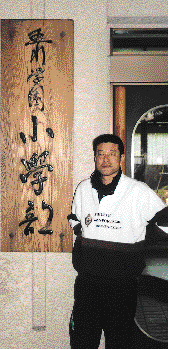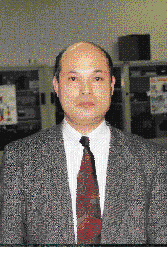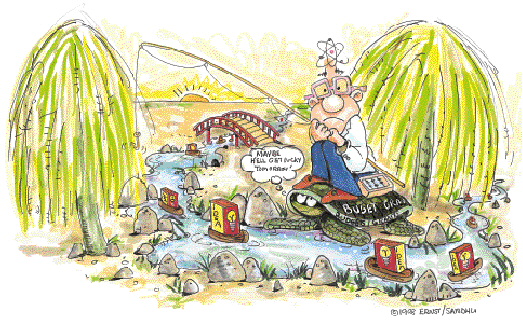Interviews
The topic of this issue is science education for children at the primary and high school level. We now report conversations of interviews with Mr Kiharu Oguro of Tamagawa Gakuen Primary School and Mr Hiroshi Masuko of Azabu High School. They both teach science to children: Mr Oguro teaches children from ages 6 to 11 and Mr Masuko teaches children from age 12 to 17. We hope that their ideas about teaching and their hopes and concerns for the future of science education for children will make a positive contribution to the current debate on education at primary and secondary school levels.
Mr Kiharu Oguro
Tamagawa Gakuen
Primary School, Tokyo
OBI: How do you interact with children who have only just left kindergarten?
Mr Oguro: Children in the first grade and second grades are only 6 or 7 years old, so they are at the stage of learning how to behave as part of a social group. They have lived with their parents and brothers or sisters, but they have yet to experience living as member of any other kind of group. They must practice what they have been told at home about good manners, eating properly in company and so on. So the first couple of years are spent establishing the basic foundations of everyday life outside the home. The 3rd and 4rd grades are then devoted to studying particular subjects.
OBI: In your experience, for what length of time can 1st and 2nd graders concentrate on listening to you during class time?
Mr Oguro: If I only talk, then about 15 to 20 minutes! But when I teach science and use a variety of interesting equipment, they will quite often listen for 40 to 50 minutes and time goes by very quickly.
OBI: Do you have a particular method of teaching science to such young children?
Mr Oguro: I do not really "teach them" science; I encourage them to think about why particular things happen the way they do to try to solve problems by themselves and not to be afraid of making mistakes.
OBI: Can you give an example?
Mr Oguro: Yes, let's take this example. What happens if you heat water in a beaker? Will the volume change just by heating? Will it become larger or smaller - or will there be no change whatsoever? So I "throw" them a problem. They each make a choice and write down why they decided on a particular answer. The answers are usually based on personal experiences, such as the pupil who remembered that when his mother filled a saucepan with water it boiled over into the cooker. So he thought that the volume would increase and his forecast and reason were based on that observation. Or there was the boy who wrote that the volume should decrease because he remembered that when his mother boiled some water and left for a while he came back to find that it had "disappeared".
OBI: What else do you ask the children to write?

Mr Oguro: I ask them to write down how they would experimentally check their forecast results; the most efficient method; how long it would take; what aspects would be dangerous, such as when using fire, and so on. That is when I ask them to write down the whole procedure for carrying out an experiment.
OBI: And do you actually let them do the experiment?
Mr Oguro: Yes. The 4th graders do their experiments in small groups. I explain how the main equipment is to be used, such as alcohol lamps and in some cases I demonstrate the use of the particular pieces of equipment.
OBI: What do you do when they have finished the experiment?
Mr Oguro: First, I ask the children to present their results and compare them with their forecasts. Then I ask them to write down their interpretation based on their actual results, whether the results were right or wrong. After that, I speak for a few minutes about the experiment and give them examples of everyday situations where similar results can readily be seen. For example, "Air also expands when heated: the size of a bicycle or car tire is different in the summer and winter; the tyre tube life-buoy when that you play with at the seaside becomes much harder if you leave it in the sun. Have you noticed?" As a finale I leave a them with a few questions to think about. How does heat travel through the water? What would happen if a metal was heated? Related topics...
OBI: Have you found that children like or dislike any particular kinds of experiments?
Mr Oguro: Yes. Children like experiments where rapid changes can be seen and the results are easy to attain. They dislike experiments where changes are slow or results difficult to get. Chemistry experiments are popular but biology experiments, such as looking at differences in the growth rates of plants in the dark and daylight, are not so well liked. They take too long before results can be seen!
OBI: Do you have any explanation as to why children are keen to think and play with science at primary school age, but at 18 or so they tend to move more towards the arts subjects? The rika-banare.
Mr Oguro: One problem is that many teachers at primary and high school teaching science subjects do not have a background in science themselves; they are mostly from arts backgrounds. I must add, though, that this is not the case at my school, Tamagawa Gakuen. These teachers went on to study arts because they themselves disliked maths and science in their younger days. The result is that they do not teach children in a way that makes the subject interesting and enjoyable. As a result children lose interest in the subject at an early age. The problem lies with teachers who rely too much on videos, photographs and text books with very little experimental work to back it up.
OBI: What aspect of science or technology do you think has had the most affect on society in the 20th century?
Mr Oguro: That is a difficult question, but I think computers have really changed the world a lot. The people responsible for developing computers have changed society.
OBI: How to do think computers will be used in educating primary school children?
Mr Oguro: As a tool for learning, and for communicating. At Tamagawa we have an exchange programme with a similar school in California and we use computers to hold regular discussions about the environment, using video cameras over the Internet. This helps the children experience the English language at first hand. We have also started a new network called "Chat-Net" for communication between the school, parents and children via the Internet using electronic mail. We teach the children the basics about how to use computers. Being children, they absorb new ideas quickly and the 10-11 year-old children are already quite competent.
OBI: What do you do in your spare time? Do you have any particular hobbies or past-times?
Mr Oguro: I enjoy sports, especially basket ball. I am head of the school Basket Ball Club, so it does occupy a lot of my time. But I enjoy most sports- and popular music, too. Above all, I enjoy watching people "doing their best" (isho-ken-mei) in whatever activity it happens to be!
OBI: Finally, a difficult question. What would you like to have with you if you were stranded on a desert island, always assuming that you had sufficient provisions?
Mr Oguro: I think fishing tackle, and diving equipment; things that would be seem to suit the atmosphere of a desert island. But the most fascinating thing about a desert island for me would be that there would literally be nothing there!
Interview by Adarsh Sandhu
Further information:
http://www.tamagawa.ac.jp/
Mr Hiroshi Masuko
Azabu High School, Tokyo
OBI: Why did you decide to become a high school teacher?

Mr Masuko: When I finished my undergraduate degree at Waseda University I was not too sure what I wanted to do, so I decided to stay on and do a Master's degree. It was during this time that I first thought about becoming a teacher. I then had to pass an examination to get the qualification to become a school teacher and here I am.
OBI: Can you tell us a little about the history of your school, the number of students and so on?
Mr Masuko: Azabu High School is a private school. It was founded in 1895 by Mr Ebara and we have a total of 1800 students at the moment. It's a boys' only school and the basic philosophy behind our education is to encourage the students to think and act according to their own judgement of a situation. We provide a relatively free and open environment with very few regulations.
OBI: What percentage of your students go on to study science at university?
Mr Masuko: It's half and half; 50 percent go onto science and the others go onto other fields.
OBI: What are the main characteristics of the science curriculum at your school?
Mr Masuko: The main feature is that we try to include as many practical experiments as possible in order to help students to understand scientific concepts.
OBI: How would describe the present state of science education in this country?
Mr Masuko: The trends are quite clear. Firstly, the percentage of class time allocated to science is such that the 6-8 age group is 0%, 8-9 is 11%, and 9-15 is 10%. At senior high school only 4 hours per week is required and all science subjects, physics, chemistry, biology, and earth sciences are selective.
Next, most science teachers at the elementary level disliked science when they were students but went on to become teachers and now have the responsibility of teaching science to youngsters. Few schools have specialist science teachers and in some cases the teachers do not know how to use equipment properly.
At at the junior high school level, there are not enough allocated class hours to teach the curriculum as required. Pupils tend to treat scientific topics as a test of memory and as the pupils progress up in years the number of students who like science goes down and those who dislike it goes up.
At the senior high school level, the is a dramatic decrease in the number students who take up science, especially physics.
Young people are interested in the fruits of science but they are not interested in being part of the process of advancing science.
OBI: What do you think are the main reasons for young children's dislike of scientific subjects?
Mr Masuko: "Efficiency!" Children want the best possible results with the minimum of effort. The process of "thinking" is quite tiresome, especially thinking about science. When you do not understand something it is usually easier to go and ask someone rather than try to resolve it yourself. We adults do it constantly. I think it reflects the society we have created where we often do not have the time to step back and think slowly and carefully about anything at all. The children are in certain respects enmeshed in a system where there is simply not enough time to think let alone contemplate.
OBI: Do you think that the rapid growth of the economy in this country has been the cause of this lack of time?
Mr Masuko: Yes. If we consider just Japan, then the sudden economic growth over the last two or three decades certainly changed our society. There are some interesting statistics which show the extent of this change in terms of junior and high school education. For example, in 1950 only about 40% of children chose to go from junior high school to high school. Yet, by 1975, about 92% of children advanced from junior high school to high school. There seemed to be no choice but to go to high school, even for those who didn't want to...
OBI: How did the high schools deal with this sudden increase in the number of high school students?
Mr Masuko: The final result is that only 40% of children want to be at high school; the remainder, and it is the majority do not. They are attending because going to high school has become a norm. So it has become extremely difficult to teach and, from the perspective of genuine students, difficult to learn.
OBI: Do you have any suggestions for resolving these issues?
Mr Masuko: I think that our educational system has already started on the road to insolvency. It has become difficult to help pupils to develop their talents because of the imbalance because of the teacher-to-pupil ratio that exists in the average school; it is difficult. The teachers do their utmost to cope with this situation but it's difficult to change without making changes in society as a whole. The phrase kisei-kanwa [OBI: deregulation] is used in economic affairs, I think a form of educational kisei-kanwa will also have to take place.
OBI: What do you think are the roles of high schools and universities?
Mr Masuko: Well, high school is the best place to learn the basics about one's country and world affairs. The role of the universities is to take over from there and teach students in greater depth about more specific topics and subject areas.
OBI: Finally, I know that you are a very busy person, but do you have any particular hobbies or pastimes?
Mr Masuko: Mountains. I enjoy all forms of activity related to mountains. I spent a lot of time in the mountains during my student days. I didn't study a lot!

Interview by Adarsh Sandhu
Further information:
Azabu High School, 2-3-29, Motoazabu, Minato-ku, Tokyo 106, Japan
